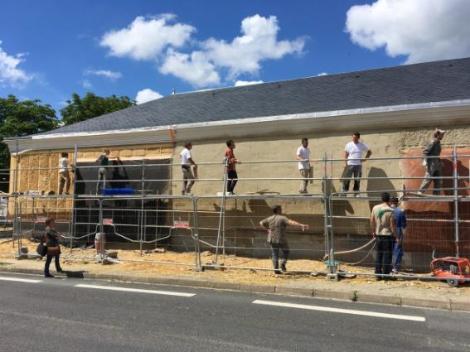Window of truth on school
Corentin Desmichelle, November 2019
Topophile - l’ami-e des lieux is the magazine of happy spaces. It questions ecologically our relationship to the world, to spaces and places, to built and natural environments, it questions our ways of building, inhabiting and thinking in order to remain fully and justly on Earth. In this article, Corentin Desmichelle presents the extension of the Bourgueil primary school in Indre et Loire: a contemporary architectural achievement in an old urban fabric, but not only!

Balance: continuity and rupture
The town centre of Bourgueil is marked by an old urban fabric. This area is characterised by the presence of buildings of great heritage quality, governed by strict forms of implantation. The building was to be built along the street. We chose to stretch it out as much as possible in order to reduce the width and create a building frontage that frames the school playground.
However, in derogation of the PLU rules, the implantation has been shifted by 1.5 m from the parcel boundary in order to introduce a vegetal strip between the public space and the school walls. This space is planted with trellised fruit bushes and edible perennials which, in the manner of the English association of Todmorden « les incroyables comestibles », encourage a public conviviality at the threshold of the school.
The technical specificity of the project comes from the composition of the envelope. The walls of the school are built of timber frame and straw insulation, rendered on the outside in raw earth with a lime finish. Inside, the walls are closed with bracing panels and gypsum and cellulose boards, which support the paint. The rooms are ventilated with a high efficiency double flow ventilation system. The thermal performance of the building meets the Passivhaus BaSE targets (max. 30 kWh/m2.year).
The architecture establishes a formal continuity with tradition (walls plastered in the same tones, slate roofing, joinery in the colours of the town) and a constructive break in the materials chosen and their implementation (wood/straw/earth vs concrete or stone).
Truth: learning and witnessing
The site was an opportunity to disseminate the know-how of earthen plaster on straw. During several days organised by the Natural Park, local masonry companies participated in the application of raw earth plaster under the direction of the craftsman (Claytech, Noé Solsona) in charge of the project.
Each classroom has a « truth window » (a glass window on the wall allowing the straw insulation to be seen). Thus, everyone can discover the nature of the walls of their school. It is interesting to note that, despite its unusual construction technique, the project is not more expensive than a conventional building. On the other hand, it will be much more economical in its operation. Indeed, it will never need to be artificially cooled in summer and its heating needs in winter are extremely reduced by the quality of its straw envelope.
Architecture is not a living machine but a living organism.
This case illustrates the superiority of simple building systems that use primary materials (stone, earth, wood, straw, etc.) to ensure comfort. In comparison, the results of complex construction methods and industrial materials are disappointing, expensive, polluting, noisy and unsightly. Architecture is not a machine for living but an organism for living.
who Atelier Desmichelle
What Extension of the Albert Ruelle primary school, 3 classes, 240 m2
where Rue Albert Ruelle, Bourgueil (37) France
when Study: 15/01/2017-15/10/2017 (9 months); Site: 15/01/2018-15/10/2018 (9 months)
why Need to extend the school and desire to use bio-sourced materials
how Concrete slab on polyurethane insulation, prefabricated wooden framework, straw bale insulation, raw earth and lime rendering, wooden framework, slate roofing, wood/aluminium double glazing, double flow ventilation, electric radiators
for whom The schoolchildren of Bourgueil at the request of the commune and the Loire-Anjou-Touraine Nature Park
with whom Architect co-contractor : Rond comme un carré; thermal and fluid design office: Energio; electrical design office: GTBE
by whom Roiffé, Cruard, Calyclay, Guillemot, Beun, Trégret, AES, Chauvat, Magalhaes, Mounier
how much
Construction: 490 000 € HT
Heating: approximately 25kWh/m2.year